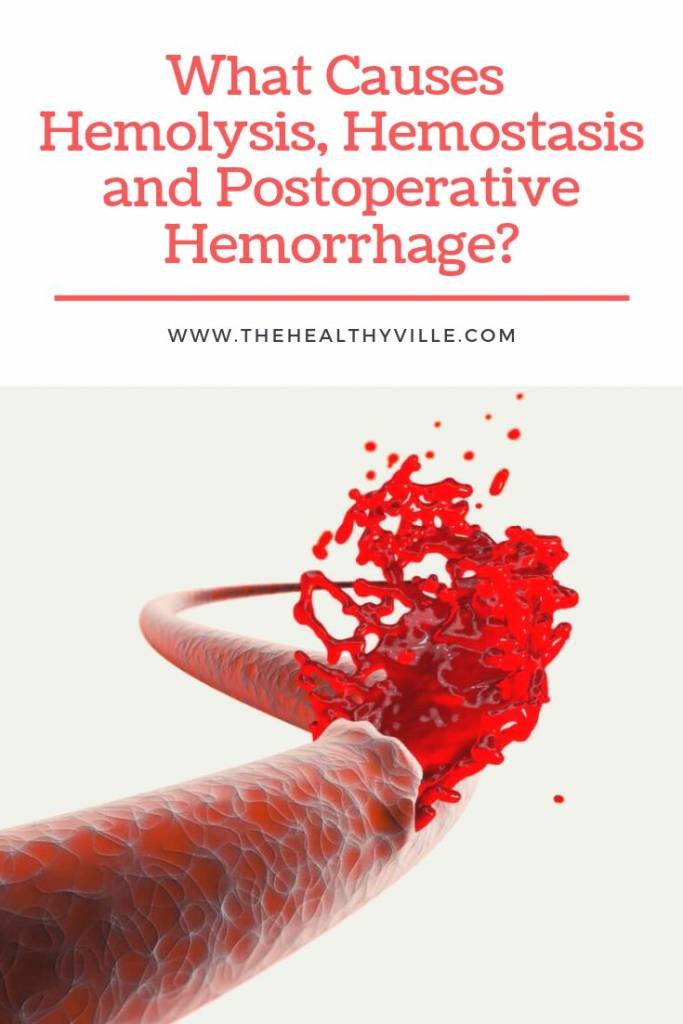Learn what causes hemolysis, hemostasis and postoperative hemorrhage in order to recognize the symptoms and react fast in case you experience them.
Surgical intervention brings great risks for venous and arterial thromboembolism. In fact, the temporary interruption of the antithrombotic treatment supposes a greater exposure to risk of thrombosis and embolism. Therefore, what causes hemolysis, hemostasis and postoperative hemorrhage is the destruction of red blood cells.
Postoperative bleeding problems may be due to the result of injury or trauma. They can also depend on blood clots. The different types of blood vessels carry oxygen and nutrients to the tissues. When blood vessels or capillaries suffer some damage, bleeding may occur inside or outside.
What causes hemolysis and hemostasis?
Hemostasis is the interruption of bleeding from damaged blood vessels, while hemolysis the destruction of red blood cells. The factors necessary for a clot to form include:
Platelets: platelets are very small cells the bone marrow produces. The normal number of platelets is 150,000 to 400,000.
Blood coagulation factors: these factors are in the blood, mainly in the liver.
Surgical intervention is associated with an increased risk of venous and arterial thromboembolism. It is also known that the temporary interruption of the antithrombotic treatment supposes a greater exposure to risk of thrombosis and embolism.
The risk of preoperative bleeding induced by oral anticoagulants is usually low. However, it is high during and after surgery, depending on the surgical procedure.
Risk factors for postoperative hemorrhage
The assessment of risk in relation to the surgical procedure is necessary in this type of patients. For this reason, the patient situation determines the type of action with respect to antithrombotic treatment.
Both the thrombotic risk and the hemorrhagic risk of the surgical procedure must be assessed. The thrombotic risk of the surgical procedure is important because of the relationship with the increased risk of thrombosis when the anticoagulant / antiaggregant treatment is interrupted.
In these cases, it is possible to opt for the continuity of the anticoagulant treatment or to interrupt it. Indicating the substitution by heparin and, later, restarting the therapy with oral anticoagulant drugs. This is due, above all, to postoperative immobility, but also to the prothrombotic effect of surgery itself.
Post-surgical hemorrhage
Major hemorrhage is the one requiring a transfusion of more than two units, reoperation or bleeding in the intracranial, intrathoracic or peritoneal cavity.
The attitude to any hemorrhagic complication will depend on the importance and location of the bleeding. It also depends on the level of anticoagulation. Major hemorrhages are also fatal or life threatening hemorrhages.
The probability of bleeding will also condition the resumption of postoperative antithrombotic treatment, since the start of anticoagulation will be deferred in cases of high risk of bleeding. If doctors suppress anticoagulation for more than one day, they should consider the possibility of administering heparin.
Resumption of anticoagulant treatment after surgery
The resumption of anticoagulant treatment after surgery should not start until 2-3 days after surgery. However, you should always use it after consulting with the specialist.
It should begin with low doses, that is, those used in prophylaxis, 2-3 days after surgery. The use of therapeutic doses starts after 48-72 hours, and doctors should not use it after continuous postoperative bleeding.
In the majority of patients treated, both with warfarin and with acenocoumarol, it can be resumed the night of the day of the intervention. This may be so as long as there are no bleeding complications.
However, the therapeutic effect will not begin until 4-5 days after beginning the anticoagulant treatment. One of the main objectives for the anticoagulated patient is to recover his antithrombotic state as soon as possible. It is necessary to take into account an adequate postoperative hemostasis and the risk of bleeding associated with the surgical procedure.
In general, most postoperative hemorrhages resolve within 24 hours after surgery. However, sometimes, this is not the case, so doctors should not start anticoagulation until hemostasis returns to normal.
Don’t forget to SHARE what causes hemolysis, hemostasis and postoperative hemorrhage with your friends and family on your social networks!

